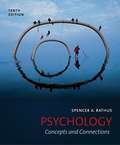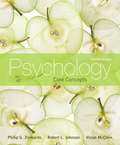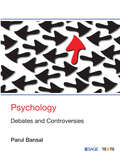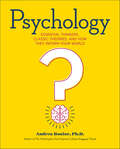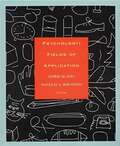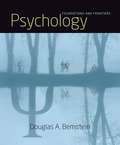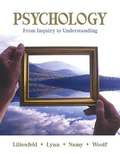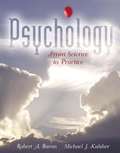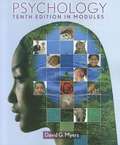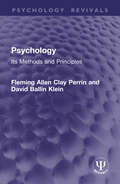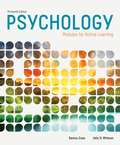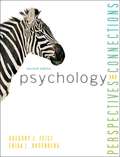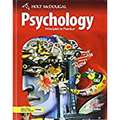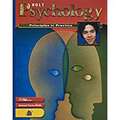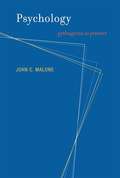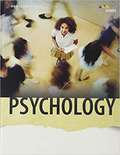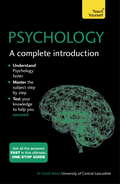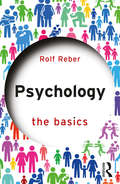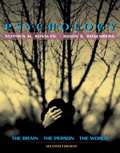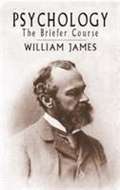- Table View
- List View
Psychology: Concepts and Connections (10th Edition)
by Spencer A. RathusRich in reader-friendly features and up-to-the-minute research, Spencer Rathus's Tenth Edition of PSYCHOLOGY: CONCEPTS AND CONNECTIONS, MEDIA & RESEARCH UPDATE EDITION makes your students' introduction to psychology a meaningful, personal experience. Rathus connects the core concepts of psychology to the events and issues students encounter every day. The book explains classic theories and the latest discoveries in a clear, accessible style intended to reach out to students-without sacrificing Rathus's commitment to showing psychology as the rigorous science that it is. Throughout the text, you'll find an emphasis on diversity and expanded coverage of the evolutionary perspective, plus numerous references to the timeliest research available. And, the text's proven active learning system, PQ4R (Preview, Question, Read, Reflect, Review, and Recite), incorporated into every chapter, seamlessly integrates reading and studying. In addition, Rathus's text features the most integrated multi-platform media package available, the full Web site that features Self-Study Assessments, Video Connections, Mobile Media and interactive versions of features from the text-all tightly connected to the text itself to give students the a powerful, comprehensive introduction to psychology.
Psychology: Core Concepts
by Philip G. Zimbardo Robert L. Johnson Vivian MccannWhere great science meets great teaching. At just fourteen chapters, Psychology: Core Concepts provides rich coverage of the foundational topics taught in most introductory courses. Psychology: Core Concepts focuses on a manageable number of core concepts (usually three to five) in each chapter, allowing students to attain a deeper level of understanding of the material. Learning is reinforced through focused application and critical thinking activities, and connections between concepts are drawn across chapters to help students see the big picture of psychology as a whole. The 7th edition features an enhanced critical thinking emphasis, with new chapter-opening "Problems" and new end-of-chapter critical thinking applications that promote active learning.
Psychology: Debates and Controversies
by Parul BansalPsychology: Debates and Controversies is about the contested nature of psychology, one of the most fascinating and important disciplines on the formation of human subjectivity. The book delves into critical debates over numerous key questions. Is psychology a natural science or a social science? Why is quantification and experimental logic so central to psychology? What kind of paradigmatic shift does qualitative research in psychology require? How does one understand an 'individual in context'? How does psychology understand the gendered basis of subjectivity? What does the medical model tell us about normality and abnormality? The book reflects upon and interrupts the dominant theories of psychology as told by academic and professional psychologists. It then aids in re-envisioning psychology along pathways that are different from the mainstream. Rather than asking the question 'which perspective is more valid?', the work strives to raise the question 'what is it valid for', which focuses the attention on the ideological ends and goals of different discourses of psychology. Key Features: • Exposes the ideological nature of mainstream scientific psychology • Critically interrogates the images of 'mind', 'individual', 'gender', 'social', 'cultural' that mainstream psychology offers • Reforms psychology along diverse epistemological and methodological lines of enquiry • Presents the salient debates in psychology in a dialogical and argumentative manner to encourage readers to become curious and seek more answers • Gathers, analyzes and re-presents the diverse strands of psychological thought available for a set of core issues under one title
Psychology: Essential Thinkers, Classic Theories, and How They Inform Your World
by Andrea BoniorAn easy-to-understand exploration of what psychology is and why it matters.Why is eyewitness testimony sometimes misleading? How does evolution explain what qualities people seek in online dating partners? These questions and many more are addressed in a convincing, thorough, and funny overview of why we are the way we are.—Dave Haaga, Ph.D., Department Chair and Professor of Psychology, American UniversityWhy do we do the things we do, think the thoughts we think, and feel the ways that we feel? Dr. Andrea Bonior has spent more than fifteen years in the field of psychology helping people discover "what makes them tick?" In her clinical practice, as well as various mental health agencies and counseling centers, she draws upon sound psychological principles to address anxiety disorders and depression, relationship issues, grief and loss, and other issues. As a mental health columnist and public speaker, Dr. Bonior encourages people to fuel their energy by connecting with themselves and cultivating the relationships around them.Psychology bridges the gap between the theoretical and real-life, creating a space where you can explore how you and others fit into it all. Dr. Bonior looks at the biggest names, ideas, and studies in the history of psychology and translates their meaning to everyday situations and relationships. Both accessible and applicable, this reference book offers a foundational understanding of the study of the mind, as well as compelling insight into your own thoughts and behaviors.Dr. Bonior covers the major fields of psychological study, including:Cognitive PsychologyBehavioral PsychologyPsychoanalytical PsychologyPersonality PsychologyDevelopmental Psychology
Psychology: Fields of Application
by Douglas A. Bernstein Astrid M. StecThis supplementary reader for introductory and applied psychology courses explores the impact of psychology on various areas of daily life, including advertising, sports, law, education, health care, and the environment. <p><p>Containing chapters written by experts in applied psychology, the texts covers a wide range of topics and provides comprehensive coverage of the field.
Psychology: Foundations and Frontiers
by Douglas A. BernsteinPSYCHOLOGY: FOUNDATIONS AND FRONTIERS introduces readers to the fascinating world of psychology by presenting important findings from established and current research, emphasizing the many ways psychological theory and research results are being applied to benefit human welfare, and providing helpful visuals and learning tools. An integrated pedagogical study system helps readers master the material step by step. Try This activities illustrate psychological principles or phenomena by providing numerous opportunities for readers to learn by doing. Other features include Linkages diagrams and sections that show readers how topics in psychology are interrelated, Thinking Critically sections that apply a five-question approach to various topics, and Focus on Research sections to help readers think objectively about research questions and results.
Psychology: From Inquiry to Understanding
by Scott O. Lilienfeld Nancy J. Woolf Laura L. Namy Steven Jay LynnLilienfeld provides the framework that students need to go from inquiry to understanding. By encouraging students to question, and teaching students how to test their assumptions, Lilienfeld motivates students to use scientific thinking skills to better understand the complex world of psychology.
Psychology: From Science to Practice
by Robert A. Baron Michael J. KalsherWith a strong emphasis on application-- without neglecting research and science-- this text focuses on helping students use the findings and knowledge of psychology in their own lives and careers. As the only introductory psychology text written by authors with extensive business experience, this book seeks the ideal balance between psychology' s "practical "and "scientific "sides. It highlights psychology' s scientific nature while simultaneously emphasizing its practical value-- how students can actually use and apply the material they read on the job and outside of the classroom. "Psychology: From Science to Practice" emphasizes three key goals: Make it clear to students how they can actually use the findings and knowledge of psychology in their own lives and careers. Present psychology as a science. Discuss the major findings of psychology without overwhelming students with too much detail.
Psychology: In Modules (Tenth Edition)
by David G. MyersThis modules-based version of Myers' Psychology tenth edition breaks down the book's 16 chapters into 54 short modules. The condensed text allows students to better grasp and explore psychological concepts. It also makes for more flexibility in teaching, as cross-references to other chapters have been replaced with brief explanations.
Psychology: In Search of the Human Mind (4th Edition)
by Robert J. SternbergSternberg (psychology, Yale University) emphasizes the theme of unity in psychological sciences in this fourth edition. This edition has been edited for readability and interest, and includes new boxed features on how psychologists from different disciplines would treat the same condition. Also new are expanded quizzes, critical thinking questions, and chapter summaries. The CD- ROM contains animations, activities, and videos. Annotation (c)2003 Book News, Inc., Portland, OR (booknews.com)
Psychology: Its Methods and Principles (Psychology Revivals)
by Fleming Allen Perrin David Ballin KleinFirst published in 1927, the original blurb of Psychology: Its Methods and Principles reads: "In this book psychology is presented as the science of adaptive behavior. The writers are convinced that the study of such behaviour provides a more effective introduction to psychological science than the study of consciousness as such. They are not committed, however, to the tenets of any particular psychological ‘school’. They have utilized both behaviouristic and introspective material without attempting to distinguish between ‘introspection’ and ‘verbal report’. Throughout the text stress is placed upon the scientific methods by means of which adaptive behaviour is investigated in the psychological laboratory." Today it can be read in its historical context.This book is a re-issue originally published in 1927. The language used and views portrayed are a reflection of its era and no offence is meant by the Publishers to any reader by this re-publication.
Psychology: Key Thinkers, Theories, Discoveries And Concepts
by Nicky HayesOpen this book and you will Grasp the essentials Explore the mind Understand behaviour Apply psychological theory
Psychology: Modules For Active Learning, Thirteenth Edition
by Dennis Coon John O. MittererPSYCHOLOGY: MODULES FOR ACTIVE LEARNING combines the highly effective SQ4R (Survey, Question, Read, Recite, Reflect, Review) active learning system, an engaging style, appealing visuals, and detailed coverage of core topics and cutting-edge research in one remarkable, comprehensive text. Fully updated, the thirteenth edition of this best-selling book includes new and revised content, extensive special features, and integrated learning tools. While the book provides a thorough introduction to the study of psychology, its modular design and emphasis on how psychology relates to everyday life make it easy for readers to explore, enjoy, and ultimately master a wide variety of topics.
Psychology: Perspectives and Connections (2nd Edition)
by Gregory Feist Erika RosenbergIn psychology, not everything is black and white. "Psychology: Perspectives & Connections 2e " dares students to challenge their own assumptions, explore research and to not believe everything they think. The over-riding goal of "Psychology: Perspectives & Connections 2e " is to align what excites us as researchers and perpetual students of psychology with todays introductory psychology student. Feist and Rosenbergs aim is to help students understand that psychology, and much of the world around them, is more fascinating--and likely more intricate and interdependent-- than they think. Its not just black and white. And, with Connect Psychology and its adaptive learning system, students can better understand what they know and master what they dont know. Connect with science. Connect with students. Connect with Feist and Rosenbergs "Psychology 2e. "
Psychology: Preparing for the Advanced Placement Examination
by Laura Brandt Charles Schallhorn Paul Hanrahan Jeffery MioPerfect for students perparing to take the AP exam.
Psychology: Principles in Practice
by Spencer A. RathusNever HIGHLIGHT a Book Again! Virtually all testable terms, concepts, persons, places, and events are included.look no further for study resources or reference material. Cram101 Textbook Outlines gives all of the outlines, highlights, notes, and practice-tests for your textbook. Only Cram101 is Textbook Specific. Cram101 is NOT the Textbook.
Psychology: Principles in Practice
by Spencer A. RathusEvery day, psychologists study a fascinating topic--people. Why do they do this? To learn why people act and think the way they do.
Psychology: Principles in Practice
by Spencer A. RathusOne needs to develop a variety of critical thinking skills to fully grasp the range of concepts and methods used in the study of psychology and this book guides one to achieve that.
Psychology: Principles in Practice
by Spencer RathusPsychology: Principles in Practice by Spencer Rathus.
Psychology: Pythagoras to Present
by John C. MaloneCertain ideas have preoccupied thinkers since ancient times: the nature of mind, the sources of knowledge and belief, the nature of the self, ethics and the best way to lead our lives, the question of free will.
Psychology: Teach Yourself
by Sandi MannWritten by Dr Sandi Mann, Senior Lecturer at the University of Central Lancashire, Psychology: A Complete Introduction is designed to give you everything you need to succeed, all in one place. It covers the key areas that students are expected to be confident in, outlining the basics in clear jargon-free English, and then providing added-value features like summaries of key experiments, and even lists of questions you might be asked in your seminar or exam.The book uses a structure that mirrors the way Psychology is taught on many university courses. Chapters include key topics in psychology research; cognitive issues, including language, emotion, memory and perception; individual differences - intelligence, personality and gender; social psychology; mental health and psychological disorders/abnormal psychology and the treatment of such; the nervous system; and sleep.
Psychology: The Basics (The Basics)
by Rolf ReberThis compact introduction is the ideal primer for anyone looking for an accessible overview of the basic principles of psychology, the fascinating science of mind and behavior. In everyday life we often ask why people act the way that they do, especially when we encounter or hear about puzzling behavior. Psychology: The Basics introduces everyday explanations of behavior, considering them through a psychological lens. Illustrating how behavior can be explained through fundamental psychological principles, the book covers the core areas of cognitive, developmental, and social psychology as well as behaviorism, the human brain, our emotions, personality and individual differences, and psychological disorders. This book, which includes further reading in each chapter for those wishing to study more deeply, is the perfect easy-to-understand introductory text for students, teachers, health personnel, human resource managers, administrators, and anyone interested in the human mind and behavior.
Psychology: The Brain, The Person, The World, Second Edition
by Robin S. Rosenberg Stephen M. KosslynThis innovative text examines psychological concepts from the levels of the brain, the person, and the social world in order to help students actively apply psychology to their lives. Through their own research, clinical work, and experiences as teachers, Stephen Kosslyn and Robin Rosenberg have found that exploring psychology from multiple perspectives further enhances learning. Examining psychological concepts from the levels of the brain (biological factors), the person (beliefs, desires, and feelings) and the world (social, cultural, and environmental factors) and their interactions helps students organize and integrate topics within and across chapters and actively apply psychology to their lives. The second edition has an increased emphasis on the process of psychological research so that students can better appreciate the science of psychology. The Second Edition includes an additional chapter devoted to research methods (Ch. 2) and a new in-text feature called "Understanding Research."
Psychology: The Briefer Course
by William JamesAmerican psychologist and philosopher James (1842-1910) examines a wide range of topics such as the importance and physical basis of habit, stream of consciousness, self and the sense of personal identity, discrimination and association, the sense of time, memory, perception, imagination, reasoning, emotions compared to instincts, the will and voluntary acts, and other subjects.
